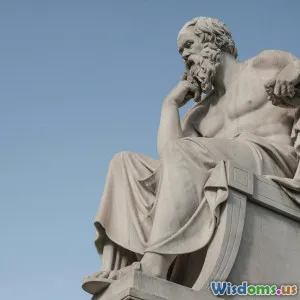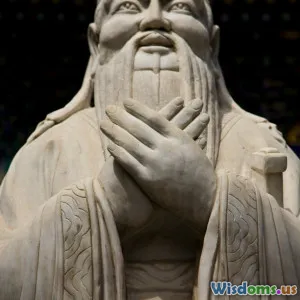
A Journey Through Pre Socratic Theories of Nature
17 min read Explore key Pre Socratic philosophers and their groundbreaking theories about the nature of the universe and reality. (0 Reviews)
A Journey Through Pre Socratic Theories of Nature
The origins of Western philosophy trace back to a time before Plato, when intrepid thinkers sought to explain the world’s mysteries without recourse to myth or divine intervention. These Pre-Socratic philosophers, operating in the polyglot atmosphere of Ancient Greece from the 6th to 5th centuries BCE, passionately argued their vision of nature’s underlying principles. Their inquiries laid the groundwork for scientific reasoning, focusing on observable phenomena rather than supernatural explanations. Our journey through their divergent yet insightful ideas unlocks not only the birth of rational thought but our modern sense of inquiry itself.
The Milesians: Searching For The Arche of Everything

In Miletus, a bustling city along Asia Minor's coast, a movement emerged determined to question traditional mythological accounts of creation. Three figureheads—Thales, Anaximander, and Anaximenes—sparked a revolution by asking a profound question: "What is the fundamental stuff from which everything originates?"
Thales and the Primacy of Water
Thales (c. 624–546 BCE), often regarded as the first philosopher, proposed a single substance as the root of all reality: water. Observing nature, Thales noticed that all living things depend on water, and it changes state, transitioning between vapor, liquid, and solid. His insight revealed an early grasp of the concept that apparent diversity in nature might spring from a unified underlying substance. Thales' hypothesis may seem unsophisticated today, but his method—privileging rational analysis over myth—signaled a radical break from tradition.
Anaximander’s Aperion: The Boundless
Thales’ student, Anaximander (c. 610–546 BCE), challenged his mentor, proposing instead an indefinite substance he titled the apeiron (the "boundless"). Unlike Thales’ water, the apeiron was eternal, limitless, and immortal—an abstract source from which all things emerged and to which they would return. Anaximander's bold abstraction demonstrated pioneering use of generalization in understanding the cosmos. He even speculated about the Earth floating freely in space, an idea unchained from prior mythical supports, hinting at a principle of equilibrium that would persist for centuries in physics.
Anaximenes: Air as the Cosmic Principle
Following this intellectual lineage, Anaximenes (c. 586–526 BCE) identified air as the primal element. For him, air was both infinite and observable, transforming into different forms (e.g., clouds, wind, water) by processes of rarefaction and condensation. He linked natural change with states of matter, a crude precursor to later theories of phase transitions.
All three Milesians sought a rational, unifying explanation for the diverse phenomena observed in the world. Though each proposed a different primary substance, their method—observation, speculation, and critical debate—became the defining spirit of philosophy and science.
Heraclitus and the Doctrine of Flux

Amid the mountains of Ephesus, Heraclitus (c. 535–475 BCE) developed a philosophy of nature famously encapsulated in his cryptic assertion: "You cannot step into the same river twice." For Heraclitus, change—perpetual and relentless—constituted the essence of reality.
Fire as a Metaphor for Change
Heraclitus posited fire as the central element, but not merely in the literal sense. Fire symbolized transformation: it consumes, changes, and gives rise to new forms. This metaphor captures Heraclitus’s conviction that nothing remains static; the world is in a constant process of becoming. The apparent stability we see is an illusion sustained by unceasing conflict and balance between opposites—day and night, life and death, unity and diversity.
The Logos: Unity in Diversity
Most enduring of Heraclitus’s insights was the concept of the logos, an underlying reason or order guiding all change. For Heraclitus, the cosmos unfolds according to the logos, its rational structure. Distinct from the arbitrary will of the gods, the cosmos possesses coherence amid flux. His notion paved the way for thinking about laws of nature—patterned regularities that underpin but do not eliminate natural change.
Heraclitus’s vision, though harder to systematize than others, prompts us to accept uncertainty and embrace the intrinsic dynamism of nature. His reverence for change and unity amidst opposites remains influential in scientific and philosophical thought even in fields like quantum physics and ecology.
Pythagoras and the Mathematical Order of the Cosmos

Not all Pre-Socratics viewed nature through the lens of material substances or elemental forces. Pythagoras of Samos (c. 570–495 BCE) redirected attention to abstraction—particularly numbers and mathematical relationships—as the foundation of the cosmos.
Mathematics as the Key to Nature
Pythagoras and his followers, the Pythagoreans, discovered that numerical ratios underlie musical harmony. For instance, plucking strings of different lengths produced consonant intervals only when the lengths corresponded to simple whole-number ratios. They extrapolated from music to the structure of the cosmos, envisioning celestial spheres emitting a sublime harmony—musica universalis. This view established the precedent for seeing mathematical reasoning as uncovering hidden regularities in physical reality.
The Sacredness of Number
For the Pythagoreans, numbers were not mere counting-tools but had mystical and explanatory power. The number ten, for instance, was deemed perfect, representing completeness. Even concepts of opposites, such as finite/infinite and odd/even, were understood numerically. In considering mathematics as the fundamental fabric of nature, Pythagoras prefigured later developments from Plato to Galileo and Newton, who would also place mathematical descriptions at the heart of scientific explanation.
Though many of their beliefs today appear esoteric (their secretive society revolved around rituals and taboos), Pythagoras’s mathematical vision transformed our approach to understanding the universe—from geometry to astronomy, and from the sciences to philosophy.
Parmenides, Zeno, and the Illusion of Change

In stark contrast to Heraclitus, Parmenides of Elea (c. 515–450 BCE) delivered a provocative thesis that change itself was impossible. His poem, On Nature, outlines a bold metaphysical stance: only "being" truly exists, and non-being is logically unthinkable. If change were real, something would have to come from nothing, and that, Parmenides reasoned, was absurd.
Unity and the Denial of Plurality
Parmenides concluded that reality is singular, motionless, and unchanging. All multiplicity, movement, and transformation are illusory perceptions shaped by our unreliable senses. This uncompromising rationalism forced a reevaluation of the nature of observation and logic. For Parmenides, trusting reason over sense-experience became a philosophical principle of the highest order.
Zeno’s Paradoxes: The Defense of Parmenidean Theory
Zeno, Parmenides’s student, defended this doctrine with ingenious paradoxes. Take his "Achilles and the Tortoise": faster Achilles can never overtake the slow tortoise, because he must always first reach the point where the tortoise was—the job being never-ending as intervals can be infinitely halved. These paradoxes highlight profound issues in the concepts of plurality, motion, and infinity that would challenge mathematicians and philosophers well into the modern era, influencing the development of calculus and set theory.
Parmenides and Zeno’s relentless logic illustrated how reasoned philosophical argument could upend everyday assumptions, catalyzing one of the most enduring problems in philosophy—the apparent contradiction between perceptual change and logical possibility.
Empedocles and the Four Elements

Where earlier thinkers championed a singular principle, Empedocles of Acragas (c. 494–434 BCE) fused tradition and innovation by positing four "roots" of all things: earth, air, fire, and water. Each element possessed unique properties, and all observed diversity in nature resulted from their blending and separation.
The Powers of Love and Strife
Empedocles introduced two cosmic forces—love (philia) and strife (neikos)—that combined and separated these elements. The drama of the cosmos, he maintained, is the perpetual interplay between these unifying and dividing principles. This dualism allowed a dynamic account of both permanence and change, bridging Heraclitus’s flux and Parmenides’s unity.
A Proto-Theory of Evolution?
Empedocles went further, speculating that life originated from chance combinations of elements, and only those forming viable creatures survived—a precursor to selection, resembling ideas in evolutionary biology. He described fantastic creatures (such as heads without bodies or bodies without heads) that failed to endure. Though lacking modern genetics’ rigor, this speculation on survival hints at a rudimentary understanding of adaptation.
Empedocles’s synthesis invited future philosophers to balance the multiplicity of evident nature with a quest for unity, echoing even in Aristotle’s rigorous analyses.
Anaxagoras and the Seeds of Everything

Anaxagoras of Clazomenae (c. 500–428 BCE), building on his predecessors, observed that many substances cannot be reduced to water, air, fire, or earth. Crunching a plant’s leaf did not yield only earth or water; bread was made from various invisible elements. He posited instead a world formed by countless "seeds" (spermata)—potential, infinitely divisible bits of all qualities.
The Role of Nous (Mind)
To initiate the ordered swirl of cosmic differentiation, Anaxagoras introduced Nous—Mind or intellect—as a distinct force. Nous was pure and unmingled, setting the seeds into rotational motion, much like a craftsman organizing raw material. Unlike prior elements, Nous was abstract and conscious, although its exact nature sparked endless debate.
For Anaxagoras, everything contains a portion of everything else: what appears as single substances actually results from infinite mixtures, with dominating characteristics masking others. For instance, the whiteness of milk masks the presence (in infinitesimal form) of all other qualities. His vision presaged modern understandings of mixtures, emergent properties, and even some aspects of molecular chemistry.
The Atomists: Leucippus and Democritus

Democritus (c. 460–370 BCE) and his mentor Leucippus introduced a daring idea: everything in the universe consists of atoms—indivisible, indestructible particles—moving within a void. For them, the diversity of nature could be explained entirely by variations in atoms’ shape, arrangement, and motion.
Atoms and Void: The First Physical Model
Atoms themselves were solid, homogeneous, and varied only in figure and size—not in quality. All observed changes resulted from the rearrangement of atoms, rather than any intrinsic transformation of their nature. The void, or empty space, distinguished Atomists’ theories from almost all others, enabling motion and the possibility for large structures to be composed from seemingly indivisible parts.
Echoes in Modern Science
This reductionist account cultivated a spirit of mechanical explanation that foreshadowed developments in modern physics and chemistry. Their hypotheses, though not testable given their era’s technology, influenced later scientists like John Dalton and shaped contemporary atomic theory. Intriguingly, quantum physicists today grapple with an analogous tension between indivisibility, transformation, and subatomic complexity.
Lessons From The Pre-Socratic Explorers of Nature

Our survey of the Pre-Socratic theories of nature reveals a drama of bold thought, passionate debate, and imaginative reasoning. Each thinker approached the world’s mysteries with unique tools—observation, logic, mathematics, and speculation—testing the boundaries of what could be known. Thales sought unity in water’s caprices, Heraclitus cherished transformation, Pythagoras resonated with mathematical harmonies, Parmenides distrusted sensory illusion, Empedocles balanced elemental forces, Anaxagoras invoked mind, and the Atomists staked reality on the dance of particles in a void.
Their diversity compels us to think critically about our own explanations of the natural world. Are we seeking simple answers where there are none? How do we know what we know? These ancient investigations persist in every new scientific venture and philosophical quest. The Pre-Socratics’ relentless curiosity inspires us to explore, question, and re-imagine our place in the shifting tapestry of the cosmos, ensuring that the journey of discovery, much as they imagined, truly has no end.
Rate the Post
User Reviews
Popular Posts
















